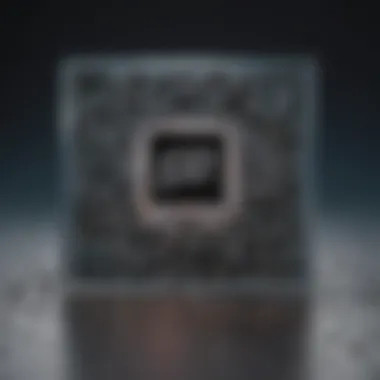Create a PayPal QR Code: A Step-by-Step Guide


Overview
Preamble to the topic of the article
Creating a QR code for PayPal can seem like a daunting task, especially for those not well-versed in technology. But fear not; this guide is here to simplify the entire process, breaking it down into digestible parts. QR codes have transformed the way transactions are conducted in today's digital age, offering a quick and effortless method for exchanging payment information. Individuals and businesses alike can reap the benefits of harnessing this technology for seamless transactions.
Brief background information
The QR code, short for Quick Response code, was developed in the 1990s for the automotive industry in Japan. Over time, its application has diversified into various sectors, including retail and finance. PayPal, as a leading online payment platform, has embraced this technology to facilitate user-friendly financial exchanges. The convenience of scanning a QR code to send or receive payments aligns perfectly with the fast-paced world we inhabit today.
Features & Specifications
PayPal's QR codes offer several notable features that enhance their functionality:
- Instant Payments: Users can scan codes to make quick payments without manually entering details.
- Customization Options: Businesses can personalize their QR codes with logos or colors, making them distinct.
- Secure Transactions: Incorporates encryption, ensuring that user data remains protected throughout the transaction process.
- Mobile Integration: Works effortlessly with smartphones and tablets, making it accessible to a larger user base.
These features cater both to casual users who want simplicity and businesses requiring a more professional touch in their transactions.
Pros and Cons
Pros
- Time-Saving: Reduces the friction in payment processes, allowing for quicker transactions.
- User-Friendly: Easy to set up and use, requiring no specialized knowledge.
- Contactless Transactions: Helps promote hygiene by minimizing physical interactions, a crucial factor post-pandemic.
Cons
- Dependence on Technology: Requires smartphone access and internet connectivity, which could be a barrier for some users.
- Potential for Scamming: Unscrupulous individuals can create fake QR codes, leading to fraudulent activities.
- Privacy Concerns: Sharing QR codes also means sharing business information; this can raise concerns about privacy and security.
User Experience
Users generally find PayPal's QR code feature to be straightforward and effective. Many customers appreciate the simplicity of scanning rather than filling in lengthy details. One user mentioned, "I love how I can just whip out my phone and scan the code instead of fumbling with cash or cards. It saves so much time!" Real-world feedback highlights that both small businesses and individuals value the approachable user experience.
Buying Guide
If you're considering integrating QR codes into your transactions, here are several points to ponder:
- Evaluate Your Need: Determine whether you’ll use QR codes primarily for personal transactions or if there's potential business application.
- Research QR Code Generators: Explore various services that generate PayPal QR codes; some platforms offer additional features, like analytics that track scans.
- Think Security: Ensure the platform has robust security measures in place. It's vital that your financial information is safeguarded.
- Cost vs. Value: Some QR code generators are free, while others come at a cost. Weigh the price against the features offered.
"Understanding the nuances of QR codes will help you make informed decisions and utilize the full potential of this easy payment method."
Foreword to QR Codes
In a world where technology is moving faster than a cheetah on the hunt, the advent of QR codes has injected a fresh dose of convenience into our daily transactions. These little black-and-white squares have become more than just an oddity to scan; they are now key players in the realm of digital payments. Given the objective of this article, understanding QR codes is not just important—it's crucial.
From small businesses to large enterprises, almost every modern transaction can now be initiated with a simple scan of a QR code. Why? Because users are looking for a seamless experience, and QR codes offer a pathway to that experience. They bridge the gap between physical and digital spaces, allowing for quick and secure payments without the need for cash, cards, or even manual entries.
Particularly, integrating a QR code into PayPal payments revolutionizes how we conduct financial transactions. It captures the essence of spontaneity and flexibility, allowing users to send and receive money at a moment’s notice. This article dives deep into the nitty-gritty of utilizing QR codes specifically for PayPal, illustrating how they can enhance payment experiences for both individuals and businesses.
Definition and Functionality
A QR code, short for Quick Response code, is a two-dimensional barcode that can store a variety of information including URLs, text, and financial data. Scanning these codes with a smartphone or a dedicated scanner instantly decodes the information contained within, opening up a world of possibilities.
One key functionality is how they link directly to payment services. When someone scans a PayPal QR code, they are often taken straight to a payment interface, allowing for swift transactions. It eliminates cumbersome processes like typing in lengthy email addresses or navigating through apps clumsily.
Moreover, they are versatile. QR codes can contain not just links to payments but can be employed for marketing, event registrations, and inventory tracking among other utilities. This versatility combined with ease of use makes QR codes a preferred tool in today's fast-paced technological landscape.
The Rise of Digital Payments
The last decade has seen an undeniable surge in digital payment methods. The world is moving away from traditional cash to digital wallets, leaving the old guard of credit and debit cards scrambling to keep up. If you consider how quickly society adopts technology, it’s no surprise that digital payment methods are right at the forefront.
QR codes feed into this movement spectacularly. With the COVID-19 pandemic accelerating the need for contactless payment options, users have become increasingly open to utilizing their smartphones to conduct transactions. This has paved the way for digital wallets and currency exchange to grow exponentially.


Businesses see this as an opportunity to streamline their processes, offering QR codes as alternatives to card swipes and cash transactions. The trend is clear: as more people get comfortable scanning codes for everything from coffee to complex financial services, the influence of QR codes in digital payments will only intensify.
"As we embrace a cashless future, QR codes stand at the intersection of convenience and security, ushering in a new era of transactions."
In summary, it’s evident that QR codes are not merely a fad; they're a formidable and innovative tool that captures the zeitgeist of today’s financial landscape. As we plunge further into this guide, the relationship between QR codes and PayPal will become clearer, helping readers understand the practical steps for their own successful transactions.
Understanding PayPal's QR Code Feature
QR codes have found a significant place in the world of digital payments, and PayPal's integration of this technology has made financial transactions simpler and faster. Understanding the PayPal QR code feature is essential for anyone looking to make the most of their financial interactions in a modern context. With the rise of contactless payments and the demand for quick, secure transaction methods, PayPal’s QR code functionality stands at the core of this shift.
Overview of PayPal's Functionality
PayPal is widely recognized as a versatile platform for sending and receiving money. It operates on the principles of convenience and security, both of which are well complemented by QR codes. When users generate a QR code through PayPal, they create a unique link to their account, enabling quicker transactions. This means that instead of sharing email addresses or phone numbers, parties can simply scan a code to initiate payments. Here's how it works:
- User-Friendly: Setting up a QR code requires just a few taps on the smartphone screen.
- Instantaneous Transactions: Payments happen almost instantly, eliminating lengthy processing times associated with traditional methods.
- Accessibility: Customers can make payments from anywhere, provided they have internet access and a compatible device.
The appeal of QR codes lies in their capacity to streamline transactions, making them particularly useful for small businesses or personal exchanges.
Benefits of Using QR Codes in PayPal
The inclusion of QR codes in PayPal comes with several enticing benefits that cater to both users and businesses. These advantages not only enhance the user experience but also promote seamless financial interactions. Here’s a closer look at some key benefits:
- Enhanced Security: QR codes minimize the likelihood of miscommunication during payment. Once scanned, the information embedded within is directly relayed to the PayPal app, providing a secure, encrypted transaction method.
- Speed: Transactions through QR codes are typically faster than traditional methods. Customers avoid the need to enter complex account details manually, which saves valuable time.
- Increased Engagement: Businesses can benefit from using QR codes in promotional campaigns, enabling customers to access exclusive deals or products directly by scanning a code.
- Reduced Errors: Manual entry of account info can lead to mistakes. QR code transactions cut this risk down significantly.
"The beauty of QR codes in digital payments isn’t just about speed; it’s about creating frictionless experiences that appeal to today’s customer service expectations."
By integrating QR codes, PayPal strengthens its commitment to innovation in handling financial transactions safely and efficiently. Whether utilizing them for day-to-day purchases or broader business applications, understanding these features helps users navigate the evolving landscape of financial technology.
Creating a PayPal Account
Creating a PayPal account is a fundamental step if you're looking to take advantage of QR code payments. This process not only opens the door to seamless financial transactions but also ensures you’re equipped for the modern digital market. By registering, you unlock the ability to send and receive money effortlessly, whether you’re a business owner or a casual user. In an age where cash transactions are steadily declining, having a reliable online payment option like PayPal allows you to easily cater to customers and clients who prefer digital payments.
When you create an account, you gain access to several useful features, including transaction records, automated invoicing, and even insights into your spending. Moreover, having a verified account enhances security aspects, ensuring that you and your customers can engage in transactions with peace of mind.
Step-by-Step Registration Process
To set up your PayPal account, follow these organized steps:
- Visit PayPal’s website or download the app on your device.
- Click on ‘Sign Up’ located prominently on the homepage.
- You’ll be prompted to choose between a Personal or Business account. Select the one that fits you best.
- Enter your email address and create a secure password. Keep this password strong to enhance security.
- Follow the prompts to fill in your personal information, like your name, address, and contact details. PayPal will guide you through what’s required.
- After submitting, look for a confirmation email from PayPal. Make sure you click on the link provided to verify your registration.
With these concise steps, registering for a PayPal account is pretty straightforward.
Verifying Your Account
Verifying your PayPal account is a smart move that elevates your account’s credibility and boosts security. Verification typically involves linking your bank account or credit card to your PayPal account. This process provides multiple benefits. For one, it allows higher transaction limits which are crucial for businesses that anticipate larger payments.
To verify your account:
- Log into your PayPal account.
- Navigate to the ‘Wallet’ section.
- Choose ‘Link a bank account’ or ‘Link a credit card’, depending on your preference.
- Follow the necessary steps to input your financial details, keeping in mind the importance of using secure connection methods.
- Once linked, PayPal will often send two small deposits to your bank account, which you will need to confirm for complete verification.
This verification not only increases the safety of financial transactions but also builds trust with others who send or receive payments from you. Trust is invaluable, especially in a digital marketplace.
Generating a QR Code for PayPal Payments
Creating a QR code specifically for PayPal transactions has become increasingly important in today's digital landscape. This feature allows users to streamline financial exchanges, providing an efficient and contact-free method for sending and receiving money. As technology continues to evolve, the utility of QR codes in payment systems cannot be overstated.
With the growing concern for contactless payment solutions, especially in the wake of global health considerations, utilizing a QR code presents an attractive alternative. It enhances the transaction experience both for customers and businesses. Users can initiate payments smoothly without the cumbersome task of entering lengthy account details. This simplicity greatly reduces the margin for error.
Navigating the PayPal Interface
Before generating your PayPal QR code, it's crucial to familiarize yourself with the PayPal interface. The layout is typically user-friendly but can seem overwhelming at first glance. Start by logging into your PayPal account. From the dashboard, look for the “Send & Request” option. This is where much of the action takes place.


Once you've clicked into that section, you’ll notice various tabs that direct you either to send invoices, request payments, or browse other features. Here’s a step-by-step approach:
- Log In to your PayPal account.
- Click on Send & Request from the top menu.
- Explore the options available — Request Money and Create Payment Links are often the most relevant for QR generation.
- If you miss this section, simply navigating back will lead you to the correct interface.
By thoroughly exploring the interface, you're better positioned to generate your QR code promptly.
Choosing the Right Options for QR Code Creation
When it’s time to create the QR code, you need to consider the specific options that PayPal provides. PayPal offers various ways to customize your QR code depending on the transaction types. Here are the considerations:
- Payment Type: Decide whether you want to create a QR code for standard payments, donations, or invoices. Each serves a different purpose and audience.
- Custom Amount: You may want to set a fixed amount in your QR code or leave it open for users to enter. Fixed amounts create clarity for services or products with set prices.
- Expiration Settings: Consider if you want the QR code to have an expiration date, especially for limited-time offers or promotional events.
Keeping these options in mind allows for a more efficient transaction that aligns with your needs and those of your customers.
Finalizing the QR Code Generation
Once you've made all necessary selections, it's time to finalize the generation of your QR code. This is usually just a click away. PayPal will generate the QR code based on the inputs you've provided. Upon generation, you can usually choose to download the QR code or share it directly through various channels.
Don’t forget to test the QR code. Scan it with a mobile device to ensure it correctly routes to the intended payment page. Having a smooth operational flow is vital; ensure all components function seamlessly before sharing it with your audience.
A good practice here is to store both the image of the QR code and the parameters you set (payment type, amount, etc.) for future reference or edits. Keeping track of how your QR code works will help you make necessary adjustments for better user experiences down the line.
Using the QR Code for Transactions
QR codes have inevitably carved themselves a niche in the world of digital payments, including platforms like PayPal. They streamline the payment process, offer convenience, and foster quick transactions, making them ideal for both casual users and businesses alike. This section delves into the practical aspects of utilizing QR codes for executing financial deals, shedding light on key elements, benefits, and considerations that come into play during these transactions.
Scanning the QR Code
The process begins with the simple act of scanning. Users can utilize their smartphones or tablets, which possess cameras capable of interpreting these codes. Most modern devices come equipped with this capability built into their camera apps, simplifying the initial step.
How to Scan a QR Code:
- Open your camera app or a QR code scanning app.
- Point your camera at the QR code without needing to take a picture. Most devices will automatically recognize the code.
- A notification will appear on your screen, directing you to PayPal for the transaction.
This convenience is a game changer! Rather than inputting complex payment details, these scans facilitate a direct link, making payments feel almost effortless. Consumers benefit from not needing to share sensitive information, ensuring that their private data sits securely out of harm’s way.
"The QR code acts as a bridge between the buyer and the payment platform, removing traditional barriers to quick payments."
Completing the Payment Process
After scanning the code, users will be navigated to a payment screen, typically within the PayPal app or website. Here, the user can see the details of the transaction—amount, recipient, and any pertinent messages. This part of the process is pretty significant, as it allows the user to double-check everything before confirming.
To finalize a payment, the user:
- Verifies the Amount: Always ensure the payment amount is correct, which can help avoid any accidental overpayments.
- Chooses Payment Method: PayPal allows users to select how they want to fund the transaction—using their balance, a linked bank account, or a credit card.
- Confirms the Payment: Finally, tapping the confirm button wraps it all up. Users often receive an instant notification confirming that the transaction has been successfully processed.
PayPal also provides a receipt feature, which can be helpful for tracking expenses or confirming purchases. This level of transparency enhances user experience and builds trust in the digital payment landscape.
By integrating QR codes into the transaction protocol, PayPal not only hastens the purchasing journey but also lifts the burden of manual entries, minimizing errors and improving user satisfaction.
Best Practices for QR Code Usage
Using QR codes can make payments more convenient, but there are best practices to ensure they serve their purpose efficiently. Understanding these best practices not only helps in creating effective QR codes but also in maintaining security and usability for everyone involved in the transaction.
Security Considerations
When implementing QR code technology for payments, security is paramount. Scammers are always on the lookout for seamless ways to exploit technologies like QR codes, thus consumers must stay vigilant. Here are key security measures:
- Authenticate Sources: Ensure the QR codes come from a trusted source. Avoid scanning codes from unverified emails or messages, as they could lead to phishing attempts.
- Use Encrypted QR Codes: Whenever possible, opt for QR codes that are encrypted. This adds a layer of security, making it harder for hackers to intercept payment information.
- Regular Monitoring: Keep an eye on transaction activity. Regularly check your PayPal account for any unauthorized transactions.
"Preventing fraud is like fortifying a castle; it requires constant vigilance and strong defenses."


- Educate Users: If you're a business owner, inform customers about safe practices for using QR codes. A simple guide can go a long way in ensuring they know what to watch out for.
Ensuring Accessibility for Users
Making QR codes accessible is vital for providing an inclusive payment experience. Not everyone interacts with technology in the same way, and factors such as age or disability can impact how users engage with QR codes. Here are steps to ensure accessibility:
- Clear Visual Design: Ensure that QR codes are large enough and have a good contrast with their background. A high-resolution image will be easier to scan than a diluted one.
- Provide Alternative Payment Options: Not all customers are ready to use QR codes. It's wise to offer alternative payment methods like cash or credit cards alongside QR options.
- User Guidance: Providing instructions on how to scan and use QR codes can help those who might not be tech-savvy. Simple, clear language is the way to go.
- Test Scanners: Different devices have varying capabilities. Ensure your QR code works with various smartphones and QR scanning applications.
By following these best practices, businesses and consumers can maximize the benefits of QR codes for payments while minimizing risks. In a landscape where digital transactions are increasingly common, ensuring security and accessibility is not just advisable; it’s essential.
Common Issues and Troubleshooting
When engaging in financial transactions through QR codes, particularly with services like PayPal, it’s crucial to consider potential hiccups that may arise. Recognizing the reality that technology doesn’t always work as intended, this section aims to provide clarity on common issues and offers practical solutions. By understanding these challenges, users can prevent misunderstandings that could affect their payment experiences.
Identifying Common QR Code Problems
There are several issues that can crop up when using QR codes for PayPal transactions. Here are some typical problems you might encounter:
- Scanning Failures: Not every smartphone camera recognizes a QR code instantly. Sometimes, the lighting or angle might make it tricky for the camera to process it correctly.
- Expired Codes: QR codes generated for specific transactions can sometimes have expiration times. Using an outdated code might lead to unexpected failures.
- Incorrect Links: Occasionally, users find that the QR code directs to a different destination than expected. This might be due to a URL problem or an error during code generation.
- Device Compatibility Issues: Some older smartphones or operating systems may not support newer QR code technology or might have outdated camera software.
Recognizing these common issues can help users troubleshoot effectively, leading to smoother transactions.
Solutions to Frequent Issues
Now that we’ve covered issues, let’s tackle how to address them effectively:
- Adjust Camera Settings: Ensure that the smartphone camera focus is on the QR code. Moving closer or angling the device differently can also help.
- Regenerate the QR Code: If a code appears to be expired or leads to the wrong page, simply generate a new QR code through PayPal. This ensures you’re working with a fresh link.
- Check Compatibility: Users with older devices should consider updating their software or using a different device altogether. It’s often a hassle but could save time in the long run if issues persist.
- Use Reliable Sources: Only generate QR codes from PayPal’s official platform to avoid issues with fraudulent sources.
- Test Before Use: If possible, run a test transaction with a trusted friend or relative. It could expose problems before they become costly mistakes.
"Technology is great when it works, but being prepared for when it doesn’t is even greater."
Taking these steps provides users with a more fortified approach to handling QR codes in payment transactions. By understanding potential issues and implementing straightforward solutions, the technicalities of using PayPal QR codes can become significantly less daunting.
Future of QR Codes in Payments
In today’s fast-paced digital landscape, QR codes have emerged as a critical tool in streamlining payment processes. Their relevance is no longer confined to advertising or marketing campaigns but has seamlessly integrated into financial transactions, particularly through platforms like PayPal. As we look ahead, understanding the future of QR codes in payments becomes vital for both consumers and businesses alike. This section delves into emerging trends and potential challenges that will shape this innovation.
Emerging Trends
- Integration with Mobile Wallets: As mobile wallets gain traction, we see QR codes becoming a mainstay for payments. Many consumers are turning to apps on their smartphones not just for convenience, but for their ability to consolidate various payment options into one place. PayPal's growing synergy with mobile wallet functionality signifies this shift.
- Contactless Payments Surge: The pandemic has changed how we transact, leading to a significant increase in contactless payments. QR codes allow users to complete payments with minimal physical interaction, which is a big plus, especially in a health-conscious environment.
- Tokenization and Enhanced Security: The future of QR payments will likely involve advanced security measures. Tokenization, a process where sensitive information is replaced with a non-sensitive equivalent, is gaining popularity. This will ensure safer transactions and boost consumer trust.
- Expansion into Emerging Markets: As more people gain access to smartphones and the internet, emerging markets stand to benefit greatly from QR code payment systems. Countries with less established banking infrastructure may find QR codes an effective tool for fostering e-commerce.
- Increased Versatility: QR codes are evolving beyond just mere payment methods. Expect to see them utilized for tracking loyalty points, issuing tickets, or even verifying identities in various sectors. The versatility of QR codes opens up new avenues that can facilitate consumer interaction and engagement in innovative ways.
"The integration of QR codes into our daily transactions is reshaping how we perceive money management and commerce as a whole."
Potential Challenges Ahead
While the future looks promising, certain obstacles threaten the widespread adoption of QR codes in payment systems:
- Security Concerns: With convenience comes the risk of fraud and misuse. Cybercriminals may exploit QR codes to redirect users to phishing sites or steal sensitive information. Continuous efforts to enhance security will be critical.
- Consumer Acceptance: Not everyone is tech-savvy. Some consumers may be hesitant to adopt QR code payments, either due to unfamiliarity or mistrust of new technology. Education and awareness campaigns will play a pivotal role in changing perceptions.
- Dependence on Technology: QR codes require a smartphone with a camera and a data connection to function. In areas with poor network coverage or where fewer people own smartphones, adoption may stall.
- Inconsistent User Experiences: Variability in how QR codes are implemented across different merchants can lead to confusion. A fragmented experience may erode consumer confidence in utilizing QR code payments.
- Regulatory Hurdles: As with any financial technology, regulations will govern how QR payments operate. Striking a balance between innovation and compliance with local laws will be essential to ensure a smooth roll-out across different regions.
End
The journey through creating a QR code for PayPal has shown us just how integral this technology has become for modern digital transactions. This concluding section highlights the essential elements covered in the article and looks ahead to what the future may hold for QR codes in payment systems.
Recap of Key Points
Throughout the article, we've traversed various aspects of generating and utilizing PayPal QR codes. Key points include:
- Understanding QR Codes: We defined their role in facilitating quick, easy payments while discussing their rising popularity in the digital landscape.
- PayPal Functionality: By unpacking PayPal’s specific QR code feature, we highlighted its unique advantages, like convenience for merchants and users alike.
- Creation Process: The step-by-step registration and account verification processes were detailed, guiding readers through the navigation of the PayPal interface and the QR code generation process.
- Usage and Troubleshooting: We provided insightful best practices for using QR codes securely and addressed common pitfalls and solutions to help users troubleshoot any issues.
- Future Trends: The examination of the emerging trends and potential challenges in the world of QR codes shed light on the continually evolving landscape of payment technologies.
By recapping these essential highlights, readers have a structured understanding of how to navigate the world of PayPal QR codes effectively.
Future Implications for Users
As we think about the future implications for users, it's clear that QR codes will continue to play a pivotal role in reshaping payment processes. Users can expect enhancements in security features, ensuring that transactions remain safe from potential fraud. Moreover, the integration of advanced technologies—like artificial intelligence and blockchain—could further streamline the process, making transactions even more seamless.
Additionally, as digital wallets and contactless payment methods gain momentum, we may see increased functionalities in PayPal's offering of QR code capabilities. The convenience of scanning a code to complete a purchase could evolve, potentially incorporating personalized features that cater to user preferences.
In summary, while the fundamental operation of QR codes remains straightforward, their future in payments through platforms like PayPal is ripe with possibilities, offering greater efficiency and a user-friendly experience. Users who embrace these technological advances will not only keep pace with changes but also stay ahead in the world of digital transactions.







